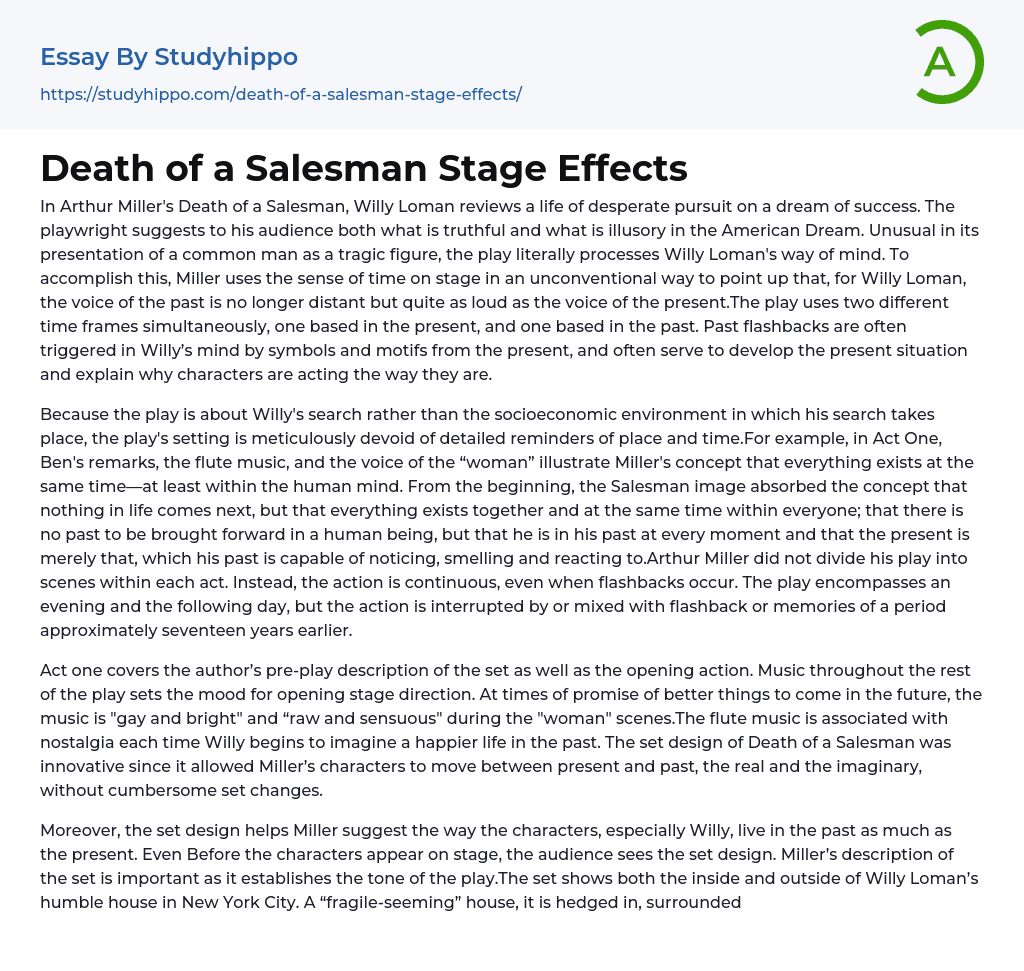Arthur Miller's Death of a Salesman delves into Willy Loman's relentless pursuit of the American Dream and explores the truth and illusion behind it. The play is unique in presenting a common man as a tragic figure, allowing Miller to portray Willy Loman's thought process on stage. The use of time in the play is particularly unconventional as Miller intertwines present and past timelines. These flashbacks are triggered by symbols and motifs in the present and help develop the existing situation, providing insight into character motives.
Arthur Miller's play focuses on Willy's search rather than the socioeconomic environment surrounding it, leading to a meticulously crafted setting devoid of detailed time and place reminders. Act One exemplifies Miller's idea that everything exists simultaneously within the human mind, with Ben's remarks, flute music, and a voice representing a woma
...n providing auditory reminders of the concept. The Salesman image embodies the belief that life lacks consecutive order and instead exists altogether within each person; the past is always present, affecting one's response to the present. Miller chose to not divide his play into scenes, allowing for continuous action even in moments of flashback. A single evening and ensuing day comprise the play's timeline, intermixed with memories from nearly seventeen years prior.
The first act of Death of a Salesman includes the playwright's description of the set and the initial action. The stage direction that follows throughout the play is accompanied by music, which sets the appropriate mood. During scenes that hint at a brighter future, the music is described as "gay and bright," while "raw and sensuous" music accompanies those with a feminine presence. When Willy reminisces about happier times
in the past, the nostalgic flute music plays. The innovative set design of the play allows Miller's characters to traverse between reality and imagination, past and present with ease, without requiring major set modifications.
Miller uses the set design to convey Willy's attachment to the past. The audience is introduced to the set before the characters are introduced on stage, making Miller's description of the set important in establishing the play's tone. The set represents Willy Loman's modest home in New York City, which appears fragile and is enclosed by new apartment buildings.
The house is illuminated with blue light, creating an atmosphere of a dream. This is accompanied by an angry orange glow that colors the edge of the scene. The blue light symbolizes Willy's self-confidence, as he boldly proclaims "I could sell them!" despite the overwhelming and depressing circumstances. The dream-like atmosphere may also represent the characters' collective sense of confusion and disorientation. The towering apartment buildings surrounding Willy and Linda are a poignant reminder of his arduous years as a traveling salesman. The kitchen is the focal point of the stage, with a raised bedroom on the right.
At the back of the kitchen is an additional bedroom, and a doorway covered with a drape leads to an unseen living room. The backdrop is entirely or partly see-through. Miller clarifies that in present scenes, actors will maintain respect for the "walls" of the house and only enter through doors, while in flashbacks or reflections, the actors will walk through the transparent walls. By utilizing recall and reflection, Miller enables the audience to comprehend Willy Loman's mindset and elicits sympathy for him. Throughout the
play, Miller also employs numerous motifs and recurrent themes to convey Willy's circumstances to the audience.
Regarding plays, the speech in Death of a Salesman leans more towards realism than fantasy. It features colloquialisms, ellipses, and dashes that give the speech a stunted, everyday feel. Willy's use of cliches and lack of articulation highlights that this is a tragedy of an average man. Miller skillfully uses naturalistic vocabulary and rhythm throughout the play, despite the simplistic sentence structure. Even though this is a play and not a reality show, there are still hints of its theatrical nature, such as when Linda says "Attention, attention must be finally paid to such a person."
Intentionally, in certain parts of the play, the past and present exist simultaneously. The play was conceived with the knowledge that Loman will ultimately self-destruct. The play's structure was formulated based on the necessity to unravel Loman's memories like endless intertwined roots. Loman's struggles in the play are relatable to contemporary audiences as he deals with the stresses of modern life, such as finances, urban living, family dynamics, and employment, while facing common vulnerabilities like insecurity, uncertainty, and generational gaps in communication.
Miller illustrates the theme of human isolation and the difficulty of overcoming seemingly insurmountable challenges.
- My Dream essays
- My Dream Job essays
- A Doll's House essays
- A Midsummer Night's Dream essays
- A raisin in the sun essays
- A Streetcar Named Desire essays
- An Inspector Calls essays
- Death of a salesman essays
- Everyman essays
- Fences essays
- Hamlet essays
- Hedda Gabler essays
- Iago essays
- King Lear essays
- Macbeth essays
- Much ado about nothing essays
- Oedipus Rex essays
- Oedipus The King essays
- Othello essays
- Pygmalion essays
- Romeo And Juliet essays
- Tartuffe essays
- The glass menagerie essays
- The Importance of Being Earnest essays
- The Merchant Of Venice essays
- The Taming of The Shrew essays
- Twelfth Night essays
- Waiting For Godot essays
- Adaptation essays
- Adventure essays
- Adversity essays
- Aging essays
- Alcohol essays
- Barbie Doll essays
- Beauty essays
- Care essays
- Carpe diem essays
- Change essays
- Chess essays
- Chicken essays
- Choices essays
- Contrast essays
- Crops essays
- Development essays
- Dream essays
- Evil essays
- Experience essays
- Family essays
- Farm essays
- Fire essays




